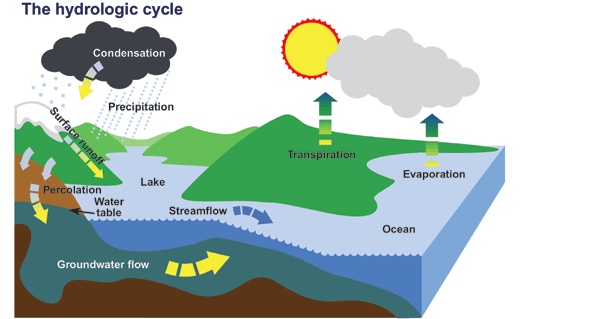The constant cycle and movement of water between the atmosphere, various bodies of water and groundwater is called the hydrologic cycle. This complex cycle revolves around the heat from the sun and involves precipitation, condensation, percolation, transpiration, evaporation and other forces which circulate water.
Contamination can occur at many points in the hydrologic cycle. When contamination occurs as a result of residential construction practices or products, it is most commonly due to contamination of groundwater or freshwater watercourses by way of the storm water system and overland flow directly into watercourses. There are many other ways in which the hydrologic cycle can be impacted by contaminants and other pollutants and it is important to note that due to the connectivity between all elements of the hydrologic cycle, contaminants can quickly become dispersed and can impact a broad range of areas.
Storm water is water than falls to the surface but is not absorbed directly into the ground. Instead of infiltrating the surface directly, storm water typically flows along paved surfaces such as roads and driveways before entering into the storm water system. The North Shore storm water system is comprised of a series of culverts that drain surface flow from roads and other paved surfaces into pipes that ultimately discharge directly into nearby watercourses. The result of this type of system is that all of the contaminants located and deposited on these paved surfaces are carried directly into the surround watercourses and watersheds of the North Shore.
Contaminated storm water enters watercourse as non-point source pollution. Non-point source pollution is pollution that originates from a variety of sources and is not easily tracked to one specific source. In urban areas, there are many sources of this type of pollution including but not limited to: fertilizers, pathogens, sediment, vehicle emissions, oil, heavy metals and other chemicals used in the construction process. The combination of multiple sources of pollutants combined with the storm water system on the North Shore means that many different types of pollutants have the potential to enter into the surrounding watershed. The interactions between contaminants in the natural environment are not yet well known and are termed cumulative effects.
The North Shore
The North Shore is a unique environment made up of three governing municipalities (The District of North Vancouver, The City of North Vancouver and the District of West Vancouver). The North Shore is surrounded by the Coast Mountains to the North, Indian Arm to the East, Burrard Inlet to the South and Howe Sound to the West. These natural barriers mean that the North Shore is for the most part geographically isolated from other municipalities. As a result of this isolation, the watersheds on the North Shore are mainly impacted by the work that takes place within the three municipalities.


